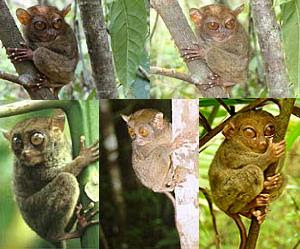The Philippine Tarsier (Tarsius syrichta), known locally as  the Maumag in Cebuano/Visayan, is an endangered tarsier species endemic to the Philippines. It is found in the southeastern part of the archipelago, particularly in the islands of Bohol, Samar, Leyte, and Mindanao. Its name is derived from its elongated "tarsus" or ankle bone.
the Maumag in Cebuano/Visayan, is an endangered tarsier species endemic to the Philippines. It is found in the southeastern part of the archipelago, particularly in the islands of Bohol, Samar, Leyte, and Mindanao. Its name is derived from its elongated "tarsus" or ankle bone.
Its geographic range also includes Maripipi Island, Siargao Island, Basilan Island and Dinagat Island. Tarsiers have also been reported in Sarangani, although they may be different subspecies. Being a member of a family that is about 45 million years old, it was only introduced to western biologists in the 18th century.
The Philippine Tarsier is a tiny animal, measuring about 4 to 6 inches (15 cm) in height. The small size makes it difficult to spot. The average mass for males is around 134 grams, and for females, around 117 grams. The average adult is about the size of a human fist and will fit very comfortably in the human hand.
Like all tarsiers, the Philippine Tarsier's eyes are fixed in its skull; they cannot turn in their sockets. Instead, a special adaptation in the neck allows its round head to be rotated 180 degrees. The large membranous ears are mobile, appearing to be almost constantly moving, allowing the tarsier to hear any movement. It has uniquely large eyes (disproportionate to its head and body), which are listed in the Guinness Book of Records as the largest eyes on any mammal. These huge eyes provide this nocturnal animal with excellent night vision.
The Philippine Tarsier has thick and silky fur which is colored gray to dark brown. The thin tail, usually used for balance, is naked or bald except for a tuft of hair at the end, and is about twice the body length. Its elongated "tarsus," or ankle bone, which gives the tarsier its name, allows it to jump at least three meters from tree to tree without having to touch the ground.[Its long digits are tipped with rounded pads that allow T. syrichta to cling easily to trees and to grip almost any surface. The thumb is not truly opposable, but the first toe is. All of the digits have flattened nails, except for the second and third toes, which have sharp claws specialized for grooming.
The dental formula is 2:1:3:3 in the upper jaw and 1:1:3:3 in the lower jaw, with relatively small upper canines.via
Other picture of Philippine tarsier.
